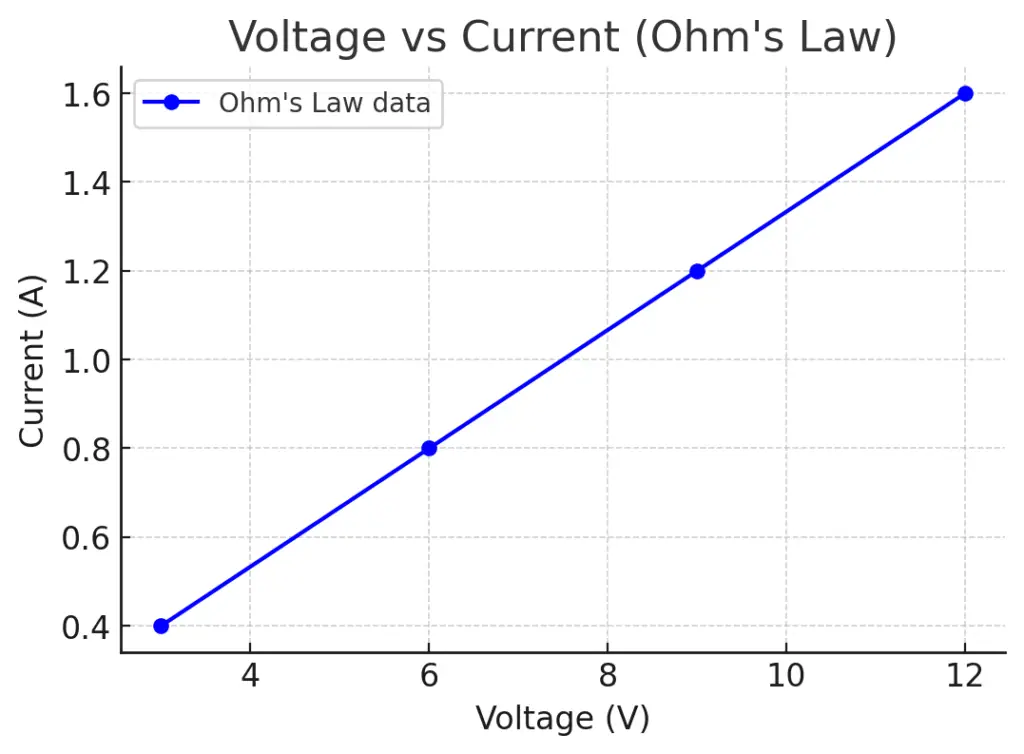We all know what happens when we turn on a torch or plug in a fan—the device starts working as soon as we flip the switch. But have you ever wondered why the current starts flowing, and how it relates to the voltage we apply? Let’s break down the relationship between current and voltage using familiar analogies and then move to the technical explanation.
Everyday Analogy: Water Flow in a Pipe
- Imagine water flowing through a pipe.
- Voltage is like the water pressure pushing the water through.
- Current is the amount of water flowing per second.
- Resistance is like the narrowness of the pipe—narrower, less water flows.
If we increase the water pressure (voltage), more water (current) flows—unless the pipe is very narrow (high resistance), which limits the flow.
Technical Explanation: Ohm’s Law
The relationship between current ($I$) and voltage ($V$) in most electrical circuits is described by Ohm’s Law:
$I = \frac{V}{R}I=RV$
- $I$ = current (in amperes, A)
- $V$ = voltage (in volts, V)
- $R$ = resistance (in ohms, $\Omega$)
Key Points:
- Current is directly proportional to voltage: If resistance is constant, increasing voltage increases current.
- Current is inversely proportional to resistance: If voltage is constant, increasing resistance decreases current.
“Ohm’s law states that the current flowing in a circuit is directly proportional to the applied voltage and inversely proportional to the resistance of the circuit, provided the temperature remains constant.”
Visualizing the Relationship
If we plot a graph of current (I) vs voltage (V) for a fixed resistance, we get a straight line passing through the origin. This shows that doubling the voltage doubles the current (if resistance doesn’t change).
| Voltage (V) | Current (A) |
|---|---|
| 3 | 0.4 |
| 6 | 0.8 |
| 9 | 1.2 |
| 12 | 1.6 |
This linear relationship holds true for most conductors, like metals, as long as temperature remains constant.
Above graph shows how current increases linearly with voltage, in accordance with Ohm’s Law.
Also Read: Ohm’s Law Verification
Cause and Effect
- Voltage is the cause; current is the effect. Current cannot flow without voltage.
- Think of voltage as the “push” and current as the “movement” that results from that push.
Practical Example
Suppose we have a resistor of $2\,\Omega$ and apply a voltage of $6\,V$:
$$
I = \frac{V}{R} = \frac{6}{2} = 3\,A
$$
If we increase the voltage to $12\,V$ (keeping resistance the same):
$$
I = \frac{12}{2} = 6\,A
$$
So, current doubles when voltage doubles, provided resistance is unchanged.
When Does This Relationship Not Hold?
Ohm’s Law applies to ohmic materials (like most wires and resistors). Some devices, like light bulb filaments or diodes, do not follow this simple relationship because their resistance changes with temperature or voltage.
In Summary
- Current increases as voltage increases (if resistance is constant).
- Current decreases as resistance increases (if voltage is constant).
- The relationship is given by Ohm’s Law: $I = \frac{V}{R}$.
- Voltage is the “push,” current is the “flow.”
Question and Answers
What causes a voltage to increase linearly with regards to the current?
This linear relationship occurs when we have a constant resistance, following Ohm’s law: $V = IR$ – as current increases, voltage increases proportionally because the resistance remains the same, creating that beautiful straight-line graph we see in ohmic materials like simple metal wires.
Which law describes the relationship between the voltage current and resistance?
Ohm’s Law
Can resistance be higher than voltage?
Yes, absolutely! Resistance and voltage have different units (ohms vs volts), so resistance can definitely be numerically higher than voltage – for example, we could have 100 ohms resistance with just 5 volts applied, giving us a tiny current of 0.05 amperes.

